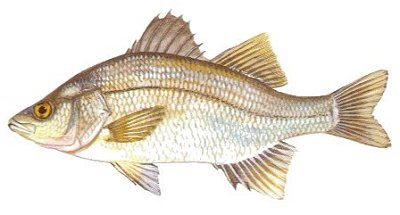Light, Air & Water
Human Vision Underwater
When light travels from a less-dense medium like air to a more-dense medium like water, the rays are refracted or bent towards the normal or perpendicular of the surface between the two mediums. In crude terms, light going from air to water will tend to be straightened, while light going from water to air will tend to be ... um ... crookeded. Confused yet? Take a look at the figure below.
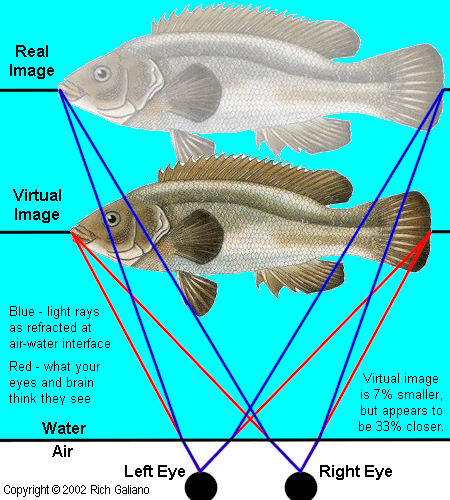
In this figure, you can see the light rays traveling from an object in the water to your eyes, neglecting the effect of the flat glass lens of your mask. The blue lines trace the actual path of the light rays through the water and into the air, or conversely, through the air into the water - the direction really doesn't matter. As you can see, the rays are bent toward the perpendicular of the surface on the water side, and away from it on the air side.
The red lines trace the continuation of the light rays on the air side as if there was no water. Your brain uses the angles on the air side to combine the images from both eyes into one, and also to calculate distance and size. There is no way for your brain to compensate for, or even be aware of, the bending of the light rays at the air-water interface, and thus the image that is constructed is wrong. Skipping a lot of complicated mathematics, the "virtual image" that your brain constructs from the composite view of both eyes is about 7% smaller and 33% closer than the real image in the water. Hence, the old adage that things look about 25% bigger underwater. Incidentally, the figures here are not mathematically precise, but they are fairly representative of the actual geometry.
Cameras Underwater
Below is essentially the same figure, drawn out instead for a camera lens. The big difference for the camera is that it has only one "eye" and therefore no need to reconcile two slightly different views into one, as we humans do. Hence, the camera does not see a virtual image underwater.* While I'm talking about housed cameras here, the same analysis holds for true underwater cameras and lenses as well.
* Not quite true - see below.


Right: A typical point-and-shoot camera housing with a flat lens port.
The problem for a camera underwater is that because of refraction, it sees a greatly narrowed slice of the world or a reduced field of view. Referring to the figure above, at the given distance, you would be able to capture the entire image in air ( red lines, ) but in water, you can only capture the part contained within the blue lines. In order to capture the entire image, it would be necessary to increase the distance to the subject - generally not a good option underwater, especially in our water! Fortunately, this problem can be solved optically.
Dome Ports

Above is a camera mounted behind a dome port - a spherical section of glass or plastic centered on the camera lens iris. Light rays pass through a dome port with no refraction, allowing the lens to see underwater the same scene that it would see in air. A dome port like
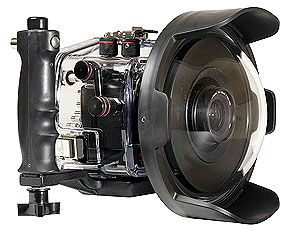
Right: A typical SLR housing with a large dome port.
This allows you to get much closer to your subject, which minimizes problems with murky water, and also allows better use of artificial lighting. This makes it useful for underwater photography under any conditions, and essential under typical North Atlantic conditions. However, a dome port is only as good as the lens behind it, so the use of a good wide-angle camera lens is essential.
A drawback of any dome port, and especially smaller ones, is that the focal plane of the image is shifted inwards, creating a virtual image as little as 12 inches in front of the camera. Some wide-angle lenses can cope with this unaided, while others require accessory lenses called diopters to allow proper focus. This is not a problem for SLR cameras but is not possible with most point-and-shoots. In fact, most point-and-shoot cameras behave very badly behind a dome port, since the 12-24" range typically falls between normal and macro focusing modes.
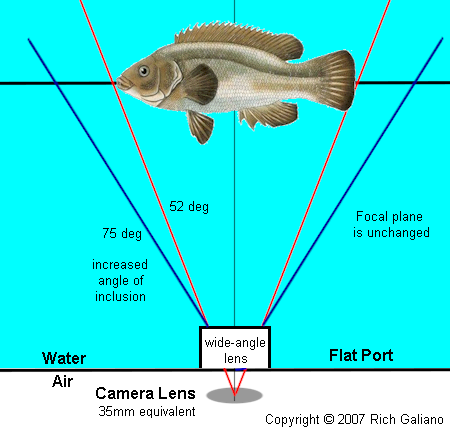
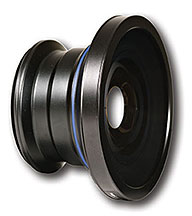
For point-and-shoot cameras, a better solution is to use an accessory wide-angle lens, also usable with SLRs. This is a watertight lens that mounts externally to the camera housing. Such a lens can have an even greater effect than a dome port, without the focusing problems that a dome introduces. As with a dome, actual results will depend on the lens used. The figures shown are representative of a 35mm equivalent lens, typical of many modern point-and-shoot cameras. An SLR would likely use a much wider lens - 10-20 mm is not uncommon, although expensive.
Drawbacks of a wide-angle lens include cost, handling, and fragility. Usually, such a lens must be attached ( or at least "burped" ) underwater to remove any air bubbles between itself and the port. Most external underwater lenses use a standard 67mm photographic filter thread - not the most robust or easy-to-use means of attachment. For the ultimate wide-angle performance, a dome port can be used with a wide-angle lens.
The downside of such wide-angle optics is that the resulting pictures tend to be distorted. This is especially obvious in scenes with a lot of straight vertical or horizontal lines. For example, look at the picture above, part of Herb Segars' superb portfolio of underwater photography. The first thing you might notice is that the barrel of the gun is curved, as is the anchor line. The distortion becomes more pronounced near the edges of the picture, especially in the corners. If you look more closely, you will also notice an overall distortion of perspective, commonly known as a "fish-eye" effect, where the center of the scene bulges toward you, and the edges fall away. This is so common in underwater photography that it is simply accepted.
Thus, extreme wide-angle lenses render rather odd photographs. But what is better, an odd photo, or none at all? That is often the choice we have when the viz is not great.
Brightness & Color
Although it appears clear, water actually absorbs light at a much greater rate than air. Not only this, but it absorbs different colors at different rates. Reds are absorbed the most, while blues and greens are absorbed the least. Therefore everything looks green. But not as green as it should be. This is because our brains can do a limited amount of color correction, tuning out the greenness of what we see, and also because under low-light conditions our vision switches from color to black and white. In black and white vision, our eyes are most sensitive to greens ( a happy accident for divers, ) although we see them as grays.
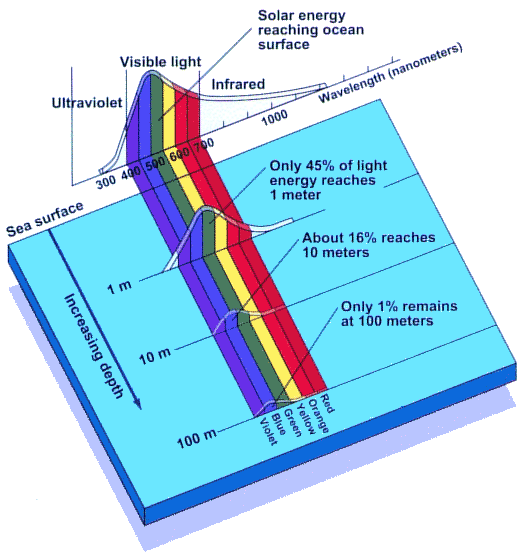
A camera, on the other hand, will faithfully record every bit of green that it sees, yielding results that are at first startling, like the green tank picture above. To capture true colors at depth, an artificial light source is needed, either in the form of a flash or a steady light. However, such a light source will inherently be of very limited power ( compared to the sun, ) and will therefore have very limited range. As the figure above indicates, 45% of the light energy is lost at a range of just one meter. This is just as true horizontally for artificial light as it is vertically for sunlight. In order for artificial lighting to be useful, it must be used at short range. This again raises the usefulness of the wide-angle optics described above, which allow larger scenes to be captured at shorter distances.

